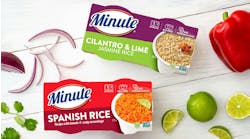Touted as a top trend for 2019 by a number of market research firms and food and beverage organizations, plant-based proteins continue to gain momentum in the U.S., with many large corporations making significant investments in this realm.
Ingredion (www.ingredion.com), Westchester, Ill., for one, announced in December 2018 it is investing a combined $140 million to further position the company as a supplier of a broad range of plant protein solutions.
“We’ve identified plant-based proteins as a high-growth, high-value market opportunity that is on-trend with consumers’ desire to find sustainable and good-tasting alternatives to animal-based proteins,” James Zallie, Ingredion’s president/CEO, said in a statement at the time.
Campbell Soup's Bolthouse Farms brand mixes both soy and almond proteins for this plant-protein beverage.
University-based food science researchers also are focusing more on plant proteins. In late November, the new Plant Protein Innovation Center (PPIC) (ppic.cfans.umn.edu) at the University of Minnesota in St. Paul held its inaugural meeting. PPIC will take an interdisciplinary approach, bringing together food and agricultural scientists from industry, academia and the public sphere as well as other stakeholders “to produce and study nutritious and functional plant protein ingredients for food applications,” as a brochure on PPIC’s website explains.
“There has been quite an increase in demand for plant protein from consumers, who are seeking alternatives to meat for many reasons,” notes B. Pam Ismail, PPIC’s director and an associate professor of food science and nutrition at the University of Minnesota. “Consumers are seeking protein sources that have health and environmental benefits, such as reducing greenhouse gases and improving land management.” Ismail’s goal is for PPIC to become an international research center.
Although soy has been the leading plant-based protein for decades — a complete protein with a Protein Digestibility Corrected Amino Acid Score (PDCAAS) of .99 (1.0 being the highest) — the clean label movement has shifted attention to other plant protein sources due to concern that soybeans are often genetically modified. Soy is also among the “Big 8” allergens in the U.S.
While pea protein is the main alternative to soy at present, other pulse proteins are gaining ground, such as chickpeas, fava beans and lentils. Additional popular plant protein sources include nut flours, especially almond flour; cereal grain proteins such as oats and teff; pseudocereal grains like amaranth and the ever-popular complete protein quinoa; and seeds such as chia and flaxseed.
Soy as a template
Benefiting from years of research and production, “Soy protein is the most functional plant protein in the market,” Ismail says. Not only is it a complete protein, soy is also very versatile and efficient, used in everything from Silk to Tofurkey.
“When soy protein was first introduced in the market, it had a stronger flavor,” Ismail notes “But over the years, processing technologies have been developed to ensure that soy is bland-tasting and, therefore, more adaptable.” PPIC aims to leverage what the industry has learned from soy and apply this knowledge and experience to other plant protein sources.
“With soy, we know, 'here is a product that works,' ” agrees M.J. Kinney, a Minneapolis-based food scientist with the Good Food Institute (www.gfi.org), Washington, D.C. “We understand its functionality to a greater extent than any other plant protein out there. So, soy can be a template for plant proteins to come.”
Pulses — rising stars
Considered to be clean label and allergen-free, pea protein’s star continues to rise. Compared to soy, pea protein has a lower PDCAAS of approximately .82. What’s more, in a typical pea protein isolate, roughly 80 percent of the of ingredient is protein compared to approximately 90 percent for soy isolates, according to Kinney.
Aquafaba, the viscous water in which chickpeas have been cooked, mimics many of the functional properties of egg whites, so it can be used as a replacement for products such as mayonnaise. Sir Kensington's is now a Unilever brand.
To attain 10g of complete protein in a product, just over 15g of pea protein isolate would be needed, she explains, noting that she arrived at that number by dividing 10 by .80 (protein percentage) and then by .82 (PDCAAS).
One challenge with pea protein and other new plant proteins is the early dominance of certain manufacturers that develop proprietary formulations, Kinney observes. “There is a lack of a standard for processing,” she says, noting that collaborative industry research needs to be done to more fully understand the manufacturing processes that affect a plant protein’s functional properties.
Minneapolis-based Puris (purisfoods.com/product/puris-pea-protein), for example, makes three pea protein isolates derived from organic, non–genetically modified peas grown in the U.S., each suitable for different applications.
- Plant proteins can face obstacles: some are only seasonal, some can be costly and many have off tastes. Learn what ingredient providers are working to overcome such challenges
One isolate the company says has high functionality and excellent dispersibility and mouthfeel is recommended for protein powders, dry beverage blends, ready-to-drink products, meat alternatives, vegan spreads and emulsified products. Another isolate, designed for applications where low viscosity and low water-hold are required, is more appropriate for nutrition bars, acidic beverages and low-pH products. The third isolate, which has a neutral pH and great extrusion properties, according to Puris, is well-suited for cereals, crisps, protein bars and high-inclusion ready-to-drink protein beverages.
Puris also claims to be the only grower of nonGMO and organic peas in the US market.
Kinney points out that food & beverage processors that source pea protein from Puris would not be able to source identical isolates from another ingredient supplier. This limitation of supply is preventing plant-based proteins from achieving even stronger market growth, she says.
When assessing whether a plant protein ingredient would be the right fit for a particular application, Kinney says food processors need to consider three key characteristics of functionality:
- Can it hold water?
- Can it form a gel?
- Is it water-soluble?
“If the protein isolate has a low water-hold and it doesn’t form a gel, it might be ideal for a beverage, which we would want to have minimum mouthfeel,” Kinney explains. “You don’t want it to be a thick sludge. But if you want to put the isolate into a plant-based meat application, you do want that strong gelation and you do want it to hold water.”
Beyond pea, other pulse proteins have seized the attention of consumers and the food industry. Ingredion recently entered into a joint venture agreement with Canadian firm Verdient Foods (www.verdientfoodsinc.com), Vanscoy, Saskatchewan, to make pulse-based protein concentrates and flours from lentils and fava beans as well as peas.
“The pulses are rich in protein and fiber, relatively low in fat, and are low-glycemic-index foods that contain various micronutrients and bioactive substances (for example, phytochemicals) for health and well-being,” says Jing Zhou a business scientist with Ingredion.
The company’s pulse-based flours, concentrates and isolates can be used in many applications. “While we continue to see a lot of growth within snack and pasta applications, there has been a lot of interest in pulse proteins for emerging application areas like meat and dairy alternatives,” points out Karen Constanza, project leader for technical development at Ingredion.
Ingredient manufacturers can blend pulses with other proteins to offset nutrient deficits. “Pulse proteins are generally rich in lysine but lack in sulfur-containing amino acids,” Zhou explains. “On the other hand, cereal proteins are usually abundant in sulfur-containing amino acids but lack in lysine. Therefore, strategically combining pulse and cereal proteins can help provide a higher protein quality than either alone.”
Vanessa Brovelli, product development manager for Quincy, Mass.-based Bay State Milling (www.baystatemilling.com), concurs that combining pulses with grains allows for optimal plant protein solutions. By combining the two, “the PDCAAS of the blend gets closer to the gold standard of 1,” she says.
Grains, seeds and nuts
Supplying a wide variety of grains, flours and seeds for baked goods, bars and breakfast cereals, Bay State Milling touts the protein content, traceability and sustainability of its non–GMO Project Verified, certified-organic SowNaked oats.
“Our SowNaked oat is a special variety, grown hulless (naked) with naturally higher protein that can be used in several applications like bars, oatmeal and oat milk to provide a plant-based protein boost,” Brovelli says.
Among seeds, flax and chia contribute omega fatty acids and functional gelling properties as well as protein, she adds. Sesame, pumpkin and sunflower seeds also provide a protein boost while contributing a nutty rich flavor and serving as a fat source.
Tree nuts constitute another critical plant protein source. With 6g of protein per ounce, almonds are the tree nut highest in protein, according to the Almond Board of California (www.almonds.com). Although widely used in European confections such as macarons and marzipans, almond flour is only beginning to command the spotlight in the U.S. as a way to add more protein to desserts, baked goods, energy bars and other food products.
Interestingly, as the recent (December 2018) Farm Bill removed hemp from the Controlled Substances Act, it now can be used as a protein source in food. Derived from the hemp seed, hemp protein contains 30 percent fat and 25 percent protein, with most of the oil composed of polyunsaturated fatty acids. According to the Hemp Industries Assn., hemp seeds are high in essential fatty acids, B vitamins and fiber.
The FDA in December said it had “no questions” about the Generally Recognized As Safe (GRAS) status of hemp seeds, oil and protein powder in response to a petition from Fresh Hemp Foods.
Formulation caveats
When blending different plant proteins or substituting higher-protein for lower-protein flours, care must be taken, Brovelli cautions.
“When replacing a portion of wheat, corn or rice flour with higher-protein grains, seeds or pulse flours, water absorption may need to be adjusted and a functional ingredient could be required in an application such as bread, where the gluten network may be disrupted by these ingredients,” she explains. “Pulse flours are known to require additional water for full hydration and functionality. Seeds such as pumpkin can add excess fat to a formulation, so other fats may have to be reduced.”
Flavor, of course, is also a major consideration. Among the pulses, lentils and chickpeas have milder sensory profiles, Brovelli says. As she observes, “the flavor of grains and seeds is sometimes easier to incorporate into the overall sensory profile of a bar or snack versus the beany note that is common with pulses.”


